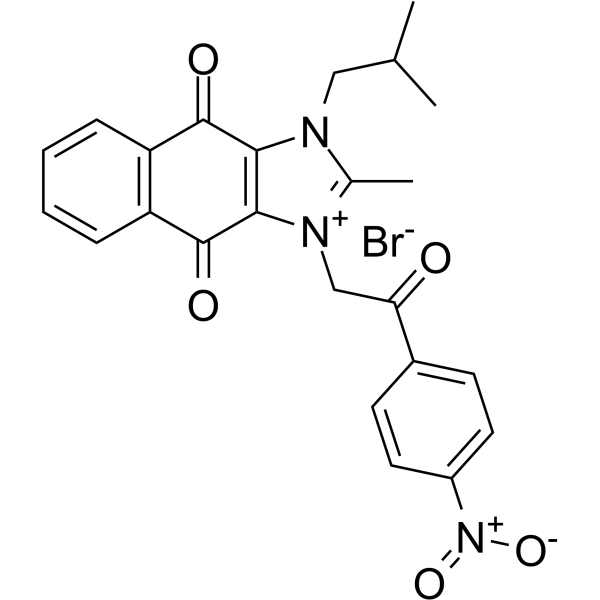Physicochemical Properties
| Molecular Formula | C24H22BRN3O5 |
| Molecular Weight | 512.35 |
| Exact Mass | 511.07 |
| CAS # | 101982-51-8 |
| PubChem CID | 24188901 |
| Appearance | Solid powder |
| Hydrogen Bond Donor Count | 0 |
| Hydrogen Bond Acceptor Count | 6 |
| Rotatable Bond Count | 5 |
| Heavy Atom Count | 33 |
| Complexity | 770 |
| Defined Atom Stereocenter Count | 0 |
| SMILES | [Br-].C([N+]1=C(N(CC(C)C)C2C(C3=CC=CC=C3C(=O)C1=2)=O)C)C(C1C=CC(N(=O)=O)=CC=1)=O |
| InChi Key | SDVDJIZVNFVMLG-UHFFFAOYSA-M |
| InChi Code | InChI=1S/C24H22N3O5.BrH/c1-14(2)12-25-15(3)26(13-20(28)16-8-10-17(11-9-16)27(31)32)22-21(25)23(29)18-6-4-5-7-19(18)24(22)30;/h4-11,14H,12-13H2,1-3H3;1H/q+1;/p-1 |
| Chemical Name | 2-methyl-1-(2-methylpropyl)-3-[2-(4-nitrophenyl)-2-oxoethyl]benzo[f]benzimidazol-3-ium-4,9-dione;bromide |
| Synonyms | NSC 80467 |
| HS Tariff Code | 2934.99.9001 |
| Storage |
Powder-20°C 3 years 4°C 2 years In solvent -80°C 6 months -20°C 1 month Note: This product is not stable in solution, please use freshly prepared working solution for optimal results. |
| Shipping Condition | Room temperature (This product is stable at ambient temperature for a few days during ordinary shipping and time spent in Customs) |
Biological Activity
| ln Vitro |
NSC 80467 suppresses survivin expression, exhibits COMPARE correlation with DNA damaging agents, preferentially inhibits DNA synthesis, and, at concentrations lower than those that can inhibit survivin expression, induces a DNA damage response marked by enhanced γH2AX and pKAP1[1]. Its spectrum of activity against the NCI-60 cell line panel is similar. NSC 80467 inhibits survival at 200 or 800 nM for 24 hours[1]. |
| Cell Assay |
Cell Line: PC3 cells Concentration: 200 or 800 nM Incubation Time: 24 hours Result: Associated with inhibition of survivin expression. |
| References |
[1]. The "survivin suppressants" NSC 80467 and YM155 induce a DNA damage response [published correction appears in Cancer Chemother Pharmacol. 2012 Nov;70(5):763-4]. Cancer Chemother Pharmacol. 2012;70(1):207-212. |
Solubility Data
| Solubility (In Vitro) | DMSO : ~25 mg/mL (~48.79 mM) |
| Solubility (In Vivo) |
Note: Listed below are some common formulations that may be used to formulate products with low water solubility (e.g. < 1 mg/mL), you may test these formulations using a minute amount of products to avoid loss of samples. Injection Formulations (e.g. IP/IV/IM/SC) Injection Formulation 1: DMSO : Tween 80: Saline = 10 : 5 : 85 (i.e. 100 μL DMSO stock solution → 50 μL Tween 80 → 850 μL Saline) *Preparation of saline: Dissolve 0.9 g of sodium chloride in 100 mL ddH ₂ O to obtain a clear solution. Injection Formulation 2: DMSO : PEG300 :Tween 80 : Saline = 10 : 40 : 5 : 45 (i.e. 100 μL DMSO → 400 μLPEG300 → 50 μL Tween 80 → 450 μL Saline) Injection Formulation 3: DMSO : Corn oil = 10 : 90 (i.e. 100 μL DMSO → 900 μL Corn oil) Example: Take the Injection Formulation 3 (DMSO : Corn oil = 10 : 90) as an example, if 1 mL of 2.5 mg/mL working solution is to be prepared, you can take 100 μL 25 mg/mL DMSO stock solution and add to 900 μL corn oil, mix well to obtain a clear or suspension solution (2.5 mg/mL, ready for use in animals). Injection Formulation 4: DMSO : 20% SBE-β-CD in saline = 10 : 90 [i.e. 100 μL DMSO → 900 μL (20% SBE-β-CD in saline)] *Preparation of 20% SBE-β-CD in Saline (4°C,1 week): Dissolve 2 g SBE-β-CD in 10 mL saline to obtain a clear solution. Injection Formulation 5: 2-Hydroxypropyl-β-cyclodextrin : Saline = 50 : 50 (i.e. 500 μL 2-Hydroxypropyl-β-cyclodextrin → 500 μL Saline) Injection Formulation 6: DMSO : PEG300 : castor oil : Saline = 5 : 10 : 20 : 65 (i.e. 50 μL DMSO → 100 μLPEG300 → 200 μL castor oil → 650 μL Saline) Injection Formulation 7: Ethanol : Cremophor : Saline = 10: 10 : 80 (i.e. 100 μL Ethanol → 100 μL Cremophor → 800 μL Saline) Injection Formulation 8: Dissolve in Cremophor/Ethanol (50 : 50), then diluted by Saline Injection Formulation 9: EtOH : Corn oil = 10 : 90 (i.e. 100 μL EtOH → 900 μL Corn oil) Injection Formulation 10: EtOH : PEG300:Tween 80 : Saline = 10 : 40 : 5 : 45 (i.e. 100 μL EtOH → 400 μLPEG300 → 50 μL Tween 80 → 450 μL Saline) Oral Formulations Oral Formulation 1: Suspend in 0.5% CMC Na (carboxymethylcellulose sodium) Oral Formulation 2: Suspend in 0.5% Carboxymethyl cellulose Example: Take the Oral Formulation 1 (Suspend in 0.5% CMC Na) as an example, if 100 mL of 2.5 mg/mL working solution is to be prepared, you can first prepare 0.5% CMC Na solution by measuring 0.5 g CMC Na and dissolve it in 100 mL ddH2O to obtain a clear solution; then add 250 mg of the product to 100 mL 0.5% CMC Na solution, to make the suspension solution (2.5 mg/mL, ready for use in animals). Oral Formulation 3: Dissolved in PEG400 Oral Formulation 4: Suspend in 0.2% Carboxymethyl cellulose Oral Formulation 5: Dissolve in 0.25% Tween 80 and 0.5% Carboxymethyl cellulose Oral Formulation 6: Mixing with food powders Note: Please be aware that the above formulations are for reference only. InvivoChem strongly recommends customers to read literature methods/protocols carefully before determining which formulation you should use for in vivo studies, as different compounds have different solubility properties and have to be formulated differently. (Please use freshly prepared in vivo formulations for optimal results.) |
| Preparing Stock Solutions | 1 mg | 5 mg | 10 mg | |
| 1 mM | 1.9518 mL | 9.7590 mL | 19.5179 mL | |
| 5 mM | 0.3904 mL | 1.9518 mL | 3.9036 mL | |
| 10 mM | 0.1952 mL | 0.9759 mL | 1.9518 mL |
